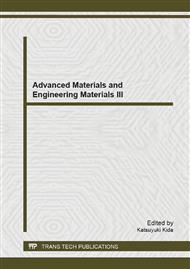p.60
p.64
p.69
p.75
p.80
p.87
p.91
p.95
p.100
Molecular Dynamics Simulation of Void Structures in Vitreous Silica
Abstract:
In order to investigate the density anomaly of vitreous silica in the medium-or long-range order, different models were made to study the atomic configuration revolution in thermal history by molecular dynamics. The void structures have been studied through analyzing the best model that is carefully selected. The principle of void size distribution revolution at elevated temperatures was used to explain the density anomaly of the vitreous silica. The simulation results showed that when the temperature is low, the void radius increases with the temperature rising. After 2000 K, large void structures are destroyed, filled, or separated into small radius voids. In the range from 2000 K to 2400 K, large void structures decrease faster exceeding the bond extension on thermal expansion contribution, this should be the root cause of negative thermal expansion behavior for vitreous silica. When the temperature is greater than 2400 K, with the temperature rising, the normal thermal expansion is recovered gradually because number of large voids has been reduced and their destroying cannot eliminate the contribution to expansion of bond extension. Therefore, the negative thermal expansion of vitreous silica could be described by the revolution of void structures in the medium-or long-range clearly, and is mainly influenced by the existence and change of larger voids.
Info:
Periodical:
Pages:
80-86
Citation:
Online since:
February 2014
Authors:
Price:
Сopyright:
© 2014 Trans Tech Publications Ltd. All Rights Reserved
Share:
Citation:


